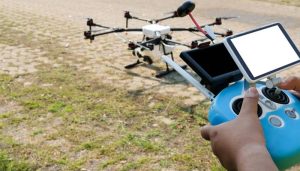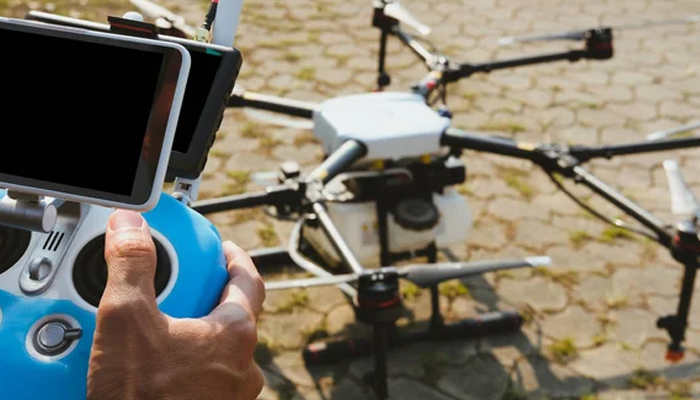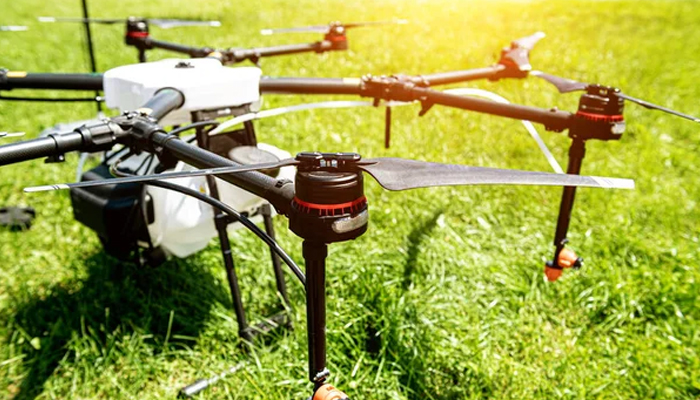Agricultural Drones: Revolutionizing Farming Practices
A drone is an unmanned aerial vehicle (UAV) or unmanned aerial system that can be operated with a remote controller. It is built with software applications that work in conjunction with sensors, GPS, cameras, etc. Drone technologies are advancing these days that allow users to gather necessary details with high-quality images. However, knowing the types of drones provides ways to select a vehicle that suits an application. Since UAV drones are well-known for their features, understanding the different types will help companies and government agencies in several ways.
Types of drones based on their wings
1. Single-rotor drone
It is a basic type that resembles a miniature helicopter, which employs a single rotor along with one central propeller that supports the body. The primary advantage of a single-rotor drone is that it can generate thrust more often than a multi-rotor drone. Single-rotor drones are suitable for aerial mapping, heavy payload delivery, aerial surveillance, etc. On the other hand, they are not stable and hover over areas.
2. Multi-rotor drone
Multi-rotor drones are the common types of drones used in several applications due to their easy take-off and precise maneuverability. They offer great control over position and framing during the operations. A multi-rotor drone is a perfect choice for recreational and professional use.
Moreover, multi-rotor drones provide greater versatility and allow users to install various types of cameras that help to perform different tasks. The drone can hover easily and lets users ensure flexibility with vertical take-off.
One of the drawbacks of operating a multi-rotor drone is that it becomes difficult to control the vehicle after adding more rotors and will result in battery drainage due to high energy consumption. It is suitable for thermal inspections, 3D scans, thermal reports, photography, videography, etc.
Multi-rotor drones have only limited endurance and speed, which are not suitable for large-scale aerial mapping. They are energy inefficient and need more energy to keep them in the air.
3. Fixed-wing drone
A fixed-wing drone looks similar to an airplane and uses thermodynamics for lift rather than rotors. It is more energy efficient than a roto-wing drone that is ideal for long-range and long-duration flights.
The fixed-wing drones are built with endurance that can fly longer and further, which helps to monitor large areas. They are ideal for asset inspections, unmanned aerial refueling, long-range payload delivery, aerial mapping and surveying, etc.
The downside of this drone is that it is highly expensive compared to a multi-rotor drone and requires a large space to take off and land. Furthermore, some larger models need specialized ground equipment during the take-off and landing process.
4. Fixed-wing hybrid VTOL drone
A fixed-wing hybrid VTOL drone is a mix of fixed-wing and rotor-based designs. The drone can take off and land vertically with multi-rotors. Apart from that, the vehicle can adjust to a horizontal flight mode that provides ways to complete tasks faster and easier.
The fixed-wing hybrid VTOL drones work well for rescue operations, mapping, surveillance, powerline inspections, etc. Operating the drone may become complex for beginners and needs more experience. Also, it can lead to high repair and maintenance costs.
Different types of drones based on their size

Drones are available in several sizes, and understanding the different types of drones based on their sizes will help make informed decisions.
1. Very small drones (nano)
Very small drones, also known as nano drones, can measure under 50 centimeters in length, and they are capable of reaching confined spaces with ease. They can weigh as little as 11 grams, which are not detected by others. A nano drone is ideal for intelligence gathering or search and rescue operations with high efficiency. It doesn’t have the stability necessary for the perfect picture taking.
2. Small drones
A small drone is usually larger than a micro drone, and the size ranges between 50 cm and 2 meters. It weighs between 200 gm and 1000 gm, which is suitable for fun outdoors and Snapchats. Small drones come in perfect sizes, and they are easy to throw up in the air.
3. Medium drones
A medium drone is larger and heavier than a small drone and has a wingspan between five and 10 meters in length. It can carry payloads up to 200 kilograms and requires at least two people to lift the vehicle. The drone is ideal for professional or military purposes, including photography or surveillance.
4. Large drones
Large drones are just like small planes, and they are mainly used for military and spy work purposes. They have excellent performance and can carry payloads over 200 kilograms. A large drone replaces a fighter jet and is known for its efficient video coverage.
Drone categories by payload capacity
1. Featherweight drones
A featherweight drone, also known as a nanoscale drone, is superlight in weight and can carry a weight of around 11 grams. The drone is also capable of loading weights that range from 4 to 100 grams.
2. Lightweight drones
A lightweight drone is a mini drone that can weigh from 200 grams to 1000 grams. It is useful for taking photos with high clarity to experience more fun and excitement.
3. Middleweight drones
A middleweight drone can weigh between 1 kg and 600 kg, and it is suitable for military and commercial purposes. The average load for a business mid-weight drone weighs from 400 to 1460 grams.
4. Heavy-lift drones
A heavy-lift drone is a giant flyer that is primarily designed for military missions, delivery, and high-precision mapping. It can weigh more than 160 kg and is capable of carrying 550 kg of payload.
Types of drones according to their abilities & equipment
1. Combat drones
Combat drones are the types of drones that are mainly used in the military for surveillance purposes. They provide methods to lower the risks associated with human lives. Due to their remote operations, operators are free from enemies that help ensure more protection. Besides, they gather accurate information in places where safety is the major concern. A combat drone is ideal for preventing the loss of a human pilot from potential threats.
2. Delivery drones
A delivery drone offers solutions for distributing packages to consumers. Leading brands such as Amazon, Walmart, Domino, and UPS conduct trial runs with them to reach customers as soon as possible. Some of them also delivered packages in particular residential areas that weighed less than 5 pounds.
3. Endurance drones
An endurance drone is a vehicle that is specifically designed for maximizing its flight time to remain operational in the air for long hours. It eliminates the need for recharging or refueling without landing. The drone is suitable for agriculture, environmental science, disaster response, telecommunications, etc.
4. GPS drones
A GPS drone is like a smartphone that transmits signals to trace a location easily. It comes with notable features that provide ways to track the necessary things with more accuracy. GPS drones have the ability to return when their batteries are low. They are suitable for aerial photography, precision farming, inspection and monitoring, search and rescue operations, etc.
5. Large combat drones
A large combat drone is mainly designed for military applications that can operate for 14 hours over a range of thousands of miles. It is around 36 ft long and can hit the targets with air-to-surface missiles and laser bombs.
6. Non-combat large drones
A non-combat large drone can perform a variety of jobs and is mainly used for large-scale reconnaissance missions. At the same time, it is more expensive than other drones and needs proper research before investing money.
7. Photography drones
Photography drones are the common types of drones used for entertainment, military, and other purposes to capture high-quality photos. However, it is wise to check the stability of these drones with more attention. Those who want to take professional-grade shots should ensure that a photography drone has a professional-grade camera. Some drones have the ability to take pictures over vast spaces with precision stability and automated flight modes.
8. Racing drones
A racing drone can reach speeds up to 60 miles per hour, and drone operators wear a head-mounted display such as goggles. Pilots can connect directly to a camera on board while flying that enables them to navigate from the drone’s eye view. The drone’s camera transmits a livestream feed to the headset, letting pilots judge their skills through a course of obstacles.
9. Reconnaissance drones
Reconnaissance drones can be used as both combat and non-combat drones in military operations. They can weigh over 2200 lbs and are capable of remaining in the air for nearly 52 hours at a height of 35,000 ft.
10. Tactical drones
A tactical drone is often used for surveillance work and is capable of carrying infrared cameras, GPS, and other features. It allows soldiers to access everything without the need for special training.
11. Target and decoy drones
The primary objective of a target and decoy drone is to divert threats effectively that help enhance security in important places.
12. Toy drones
Toy drones are the best option for beginners who want to operate them indoors or outdoors with a remote control system. They come in various shapes and sizes, which cater to the needs of beginners who want to improve their skills.
What are the types of drones that are classified according to their power sources?

1. Battery
A battery is the most important component of a drone that provides ways to ensure long flights. Drones use different types of batteries, such as NiMH, LiPo, and nickel-cadmium, which offer optimal results to users. On the other hand, operators should consider choosing a battery smartly to experience top performance and flying time.
2. Gasoline
A gasoline-powered drone is the best choice for operators to lift heavy things and take long flights to get the desired outputs. It is suitable for those who want to reduce their expenses to a larger extent. The drone can stay in the air for long hours while carrying big loads.
3. Hydrogen
A hydrogen-powered drone is ideal for high flights, and the vehicle works more quietly than other drones. Another advantage of this drone is that it is better than a regular engine in thin air, and the vehicle is more efficient at high altitudes.
4. Solar
A solar-powered drone is an eco-friendly choice for operators and uses sunlight for the charging process. It can fly longer and is suitable for long flight times by eliminating the need for recharging.
Identifying the different types of drones by number of propellers or arms
Operators can identify the different types of drones based on their number of propellers or arms that help select the best one accordingly. Moreover, they can benefit more from those that help meet their requirements.
1. Tricopters
A tricopter drone has 3 arms, and each of the front arms will have a motor that rotates in the opposite direction to generate power. The rear motor provides stability to flight by acting as a servomotor.
2. Quadcopters
Quadcopter drones are the most common types of drones that are available on the market that come with four arms. Each of them has a motor and offers greater stability to operators with high efficiency.
3. Hexacopters
The hexacopter drone has 6 arms and 6 engines, which are mostly used for professional purposes to generate high-quality aerial shots. The vehicle provides methods to install cameras and make professional-level recordings due to its excellent stability.
4. Octocopters
Octocopter drones come with 8 arms and 8 motors, and the stabilization capacity offered by the vehicle is greater than a hexacopter. However, it becomes difficult to operate the drone in small spaces due to its large size and heavy weight.
5. Coaxials
A coaxial drone will have 2 motors, and the vehicle is powerful enough to transport objects or rise to great heights without any hassles. It is suitable for taking high-quality aerial shots to perform specific tasks that involve the movement of objects.
Conclusion
Choosing a drone involves various challenges, and knowing the types of drones and other details enables operators to utilize them with high efficiency.

